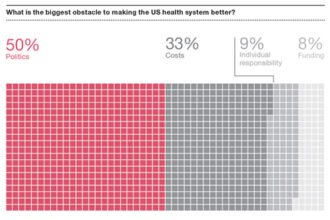Patients and providers both need to be empowered to deliver on the promises of the Affordable Care Act. That was the major theme and takeaway of the recent “Accountable Care and Health IT Strategies Summit” that I attended a few weeks ago in Chicago. I would add to this sentiment that IT needs help to implement technologies that empower these end-users.
Patients and providers both need to be empowered to deliver on the promises of the Affordable Care Act. That was the major theme and takeaway of the recent “Accountable Care and Health IT Strategies Summit” that I attended a few weeks ago in Chicago. I would add to this sentiment that IT needs help to implement technologies that empower these end-users. While not underestimating the importance of making sure technology is secure, and scalable, with too much focus on the back-end, IT can miss an opportunity to help deliver real value and change buy putting tools in the hands of end-users.
Since value-based payments require health systems to be able to impact patient behavior outside their four walls, technology (and therefore IT departments) have the ability to play a greater role in helping to monitor and manage patients, and scale healthcare providers. Access to real-time data can also help identify issues and impact patient behavior before small problems turn into big ones.
to monitor and manage patients, and scale healthcare providers. Access to real-time data can also help identify issues and impact patient behavior before small problems turn into big ones.
While some of the stories and sessions at the conference were promising, I came away with the impression that we are still in really early days, and the leaders in this care transformation are willing to take leaps without having all the data. Considering that even with data, it still takes 17 years from innovation to transfer from research to clinical best practice, it seems that some amount of faith is required for this healthcare transformation.
In no particular order, here are a few of my notes from the 2-day conference.
Theme: Population Health 2.0: Accountable Care, Big Data and Healthcare Analytics
Population Health seems the furthest along in this transformation both in the way care is delivered and how technology supports care. Participants on this panel from Partners, Geisinger, and Hackensack University Medical Center, along with population health vendor Wellcentive debated the differences between Population Health 1.0 and 2.0. They even tried to see the future with Population Health 3.0.
Population Health 1.0 was seen as identifying risk and gaps in care, and attempting to plug those gaps. Although many organizations are still in this stage, some haven’t even gotten there yet. The panel saw themselves moving to a more evolved state of Population Health where data is used to drive better care, while responsibility for population health moves to the individual primary care physician rather than being managed in aggregate by remote care teams. However, this type of shift requires engagement by both the patients and the physicians which is still a work-in –progress.
The representative from Geisinger stressed for an effective implementation of population health, a multi-disciplinary team needs to be assembled that includes both clinical and IT. Wellcentive agreed and added that analytics need to be in the hands of end-users so they can make informed decisions.
The panel was also asked to speculate on Population Health 3.0: historical data, data driven decisions, and patient empowerment through data from sensors and surveys were all seen as key.
Honestly, my biggest takeaway from this session is that while some organizations may be claiming it’s time for Population Health 2.0, many haven’t gotten to 1.0, and no one seems to be in agreement on the definitions of each stage. Given today we already have the ability to collect survey and sensor data in the context of care, it seems like we are already have the tools for Population Health 3.0. But, we haven’t implemented the technology to address Pop Health 1.0 & 2.0 to achieve value…..so how can we even look to addressing the road to 3.0?
Theme: EMRs and Enabling Technology for ACOs
Another major theme that arose across many sessions at the conference is the limitations of current technology to support the infrastructure of new models of care. While organizations are looking for the EMR to be the Holy Grail, it’s a challenge as most EMRs are built to support older models of care, specifically around billing and reimbursement. Renown Health’s Accountable Care Organization, in Northern Nevada, will look to EPIC to solve some of their technology care needs, but realizes the need for M-health and other care coordination technologies to move up the stack, and exist separately from the EMR will be required.
Many of the participants are either trying to collect and track ACO data in the EMR or build their own systems to engage patients that fed data back into the EMR. Others acknowledged that new systems to directly engage patients need to be built on new technology stacks, although surprisingly one panelist on the Connected Care – How Trends in mHealth, Wearables and Connected Medical Home are Shaping Healthcare keynote boasted about 20-30% engagement rates with paper surveys. Yes, paper.
Theme: Engaging Patients and Providers
For ACOs and the ACA in general to be effective, the consensus at the conference was the need to enable both patients and providers. Adding individual providers into the mix seems to be a bit of a shift in thinking, and one that we’re supportive of at Wellpepper. We know that a key driver of patient adherence is the relationship between patients and providers. With our system, a good provider can influence patients to be over 85% adherent to their treatment plans. Some key ideas at the conference were providers may still need to be convinced of the need to influence patients directly, and that showing them data is the way to do that. However, the method of communication to that patient needs to connect in a way that is of their everyday life routine.
Overall, the conference presented some early wins in the shift to ACOs and value-based payments, but showed that we still have a long way to go and a lot of opportunity to improve care based on data. That said, this was the first conference I’ve been to where IT was front-and-center at the table and able to drive change if they wanted to. We have an opportunity to leapfrog old ways of doing things and implement new systems that have focus on the patient and provider, and are based on data to drive better outcomes. I for one am excited about this new opportunity and how it will change the way we deliver care in the future.








